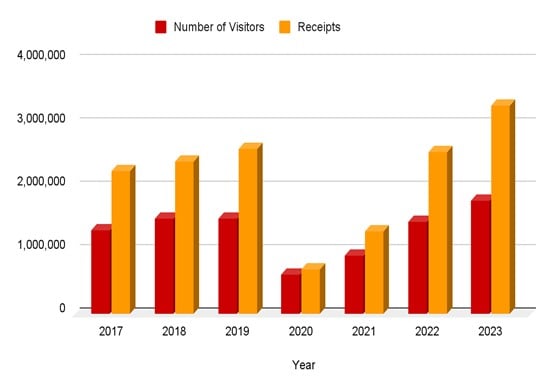In 2023, Tanzania saw a tremendous bounce back in the tourism industry, with the number of tourist arrivals and revenues surpassing the pre-pandemic levels. How can we keep the momentum going, so as to make the most of tourism’s critical contribution to forex earnings and employment in the country, and do so sustainably?
According to the Bank of Tanzania's monthly economic review of January 2024, the number of tourists who visited the country in the year ending 31 December 2023 amounted to 1,808,205, while the forex earnings reported record growth of USD 3.4 billion, an increase of 36% compared to the same period in 2022.

Source: Ministry of Natural Resources and Tourism, 2022 and December 2023 BoT MER
The FYDP III articulates a target of 5 million tourists generating USD 6 billion by 2025. At first glance the revenue target seems more achievable than the arrivals target. Assuming the growth of 36 percent continues for the next two years, the receipts from tourist arrivals would reach USD 6. 3 billion by December 2025. In addition, if as a Country, we generated USD 3.4 billion with only 1.8 million tourist arrivals, one can argue that we do not need 5 million tourists to generate USD 6 billion. Therefore, the revenue target set by the Government at first glance does not look over ambitious.
Nevertheless, the maths suggest that the initial Government’s projections may need revision. By contrast, sector stakeholders have observed that the 5 million arrivals target would represent the equivalent of 50 Airbus planes (13,700 passengers) per day arriving in the country. Clearly, the current infrastructure of our airport facilities would not be able to accommodate such a volume. For instance, Kilimanjaro International Airport can hardly accommodate two Airbuses landing at the same time, hence multiplying the arrival numbers without putting in place adequate infrastructure does not seem realistic. This is not just a question about airport infrastructure, but supporting infrastructure more generally – for example, accommodation capacity.
What is clear is that there is a tremendous opportunity to build on the recent tremendous performance of the Tourism industry, so as to optimise the future of the sector. This is made clear in the recent World Bank’s Country Economic Memorandum for Tanzania (with the theme, “Privatizing Growth”) which listed five priority policy actions to enable sustained robust growth of the economy. One of these actions was titled “Building Tanzania’s tourism back better”. In this regard, its suggestions included: ensuring accessibility of areas beyond Zanzibar and the Northern Circuit; creating an enabling business environment for private sector investment by addressing longstanding regulatory and infrastructure bottlenecks; and identification of the new regions and new service offerings for the sector’s growth.
The Government's efforts to upgrade the airports in the southern areas, which include Iringa and Mbeya, are commendable as this is a step in the right direction in the development of Tourism in the south circuit. Further, new areas for tourism growth will generate positive economic impacts and ensure the distribution of economic benefits to the local communities. For instance, the coastal regions, Dar es Salaam, Tanga, and Pwani, enriched with beautiful beaches, historical and natural attractions, have an enormous potential to become new tourist destinations.
The bottlenecks pointed out in the World Bank Country Economic Memorandum are not new: they are shared by most if not all stakeholders in the Tourism sector including as summarised in a recent Tourism Confederation of Tanzania publication (titled “Overcoming Challenges in Tanzania’s Tourism Sector – A Report on Achieving Sustainable Growth in 2024”) and are similar to concerns I highlighted in a previous September 2022 article of mine. In summary, action is needed from the Government to ensure sustainable growth in the Tourism sector.
There are also lower-hanging fruits that can be addressed by players in the Tourism sector, such as quality of human resources. According to the World Economic Forum’s Travel and Tourism Development Index, Tanzania ranks 108th in the world on human resource and labour market. While the Government has a significant role to play in education as part of improving the quality of the labor force, the players in the sector should endeavor to invest in upskilling their workforce. As part of their socioeconomic development agenda, perhaps they could work together with International Development Agencies to come up with tourism academies?
The forex earnings from tourism as of December 2023 have proven that the target of $6 billion by 2025 is not beyond reach. Nevertheless, as a country, we should not be complacent. The tourism industry has to evolve and cater to diverse demands and emerging consumer behaviors focused on sustainable tourism demand.









